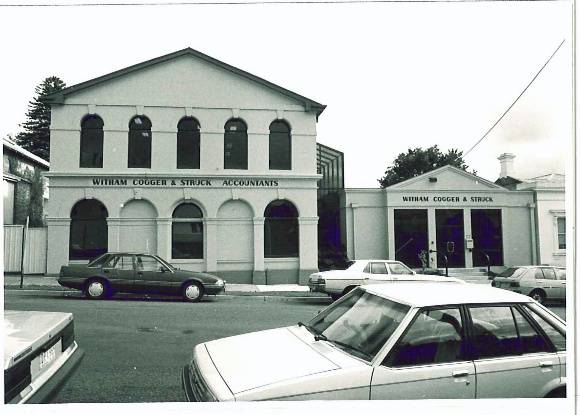| Back to search results » | Back to search page » |
|
Former Temperance Hall
Location75-77 Gray Street HAMILTON, SOUTHERN GRAMPIANS SHIRE
File NumberHAMDS072LevelStage 2 study complete |
|
Statement of Significance
SIGNIFICANCE: Originally a grain store and coach builders', this building was for a long time used as a Temperance Hall. During the Second World War it was converted to a knitting mill employing mostly females. Its strong classical lines are an important element in the streetscape. [i] Garden, D, Hamilton, p 129. [ii] Hamilton Rate Book, 1868 No 199 (store NAV 150 pounds). [iii] Ibid. 1874 No 240 (store NAV 60 pounds). [iv] Ibid. 1877 No 229 (stone store, stable NAV 60 pounds). [v] Ibid. 1884 No 234 and Garden, p 129 [vi] Ibid. p214, and Hamilton Spectator, 19 Jan 1946. [vii] HSA DP 4199.
STATEMENT OF SIGNIFICANCE
Former Temperance Hall
77 Kennedy Street
This building has local significance for its associations with the Temperance Movement which was active in Hamilton in the 1880s. ([i]) The Temerance Movement was powerful both politically and socially, especially when it was lead by James Munro, Premier of Victoria and the developer behind many coffee palaces. The hall's long history began in 1868 when a two storey bluestone grain store was erected on land owned by S Hawkins Trustees and occupied by James Bostock and Thomas C Chapman, merchants. ([ii]) By 1874, the building was occupied by Robert Wright Barber, coachbuilder. ([iii]) Later, in 1877, when it was identified as a stone store and stable, it was occupied by Henry William Thirkell, auctioneer. ([iv]) The building was converted into a single storey Temperance Hall, by the removal of the upper floor, in 1884-85 when the property was acquired by the Trustees of Hamilton's Total Abstinence Society led by Peter learmonth and store owner John Thompson. ([v]) About sixty years later the Australian Knitting Mills opened a factory in the building, employing 50 girls and women. ([vi]) Finally, in 1988, the former Temperance hall was converted back into two storey offices and extended for Witham, Cogger and Struck. ([vii])
The building is a restrained example of the neo-Palladian style usually adopted by the Public Works Department for buildings requiring a sober demeanor such as courthouses and public offices. This design, of unknown origin, may have been influenced by the local courthouse or others in the district. The building has undergone many changes in the past. The most recent included its conversion into offices which included an extension at the side. The building remains relatively intact and in good condition. It makes a critical contribution to the streetscape.
Group
Community Facilities
Category
Other - Community Facilities




